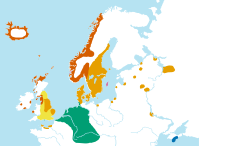
The Canterbury charm is an Old Norse runic charm discovered inserted in the margin of an Anglo-Saxon manuscript from the year 1073. [1]

The Canterbury charm is an Old Norse runic charm discovered inserted in the margin of an Anglo-Saxon manuscript from the year 1073. [1]
The runes are clear, and the transliteration of the runes is straight-forward (spaces between words not present in the original):
kuril
Gyrils
sarþuara
sārþvara
far
far
þu
þū
nu
nū!
funtin
Fundinn
is
eʀ
tu
þū!
þur
Þōrr
uigi
vīgi
þik
þik,
¶
þorsa
þursa
trutin
drōttinn,
iuril
Gyrils
sarþuara
sārþvara.
uiþr
Viðr
aþra uari
aðravari.
Gyrill's wound-tap, you go now! You are found! May Thor hallow you, lord of the trolls. Gyrill's wound-tap. Against pus in the veins (blood poisoning). [2]
Similarly, the charm is translated by Macleod and Mees (2006) as:
The charm is intended for use against a specific ailment, described as "blood-vessel pus." MacLeod and Mees note that while Thor is not revered in surviving sources for his medical abilities, he was well attested as harboring enmity towards giants and as a protector of mankind. MacLeod and Mees compare the charm to the 11th-century Kvinneby amulet (where Thor is also called upon to provide protection), the formula structure of the Sigtuna amulet I, and the inscription on a then-recently discovered rib bone also from Sigtuna, Sweden. [1]
| Part of a series on the |
| Norsemen |
|---|
 |
| WikiProject Norse history and culture |